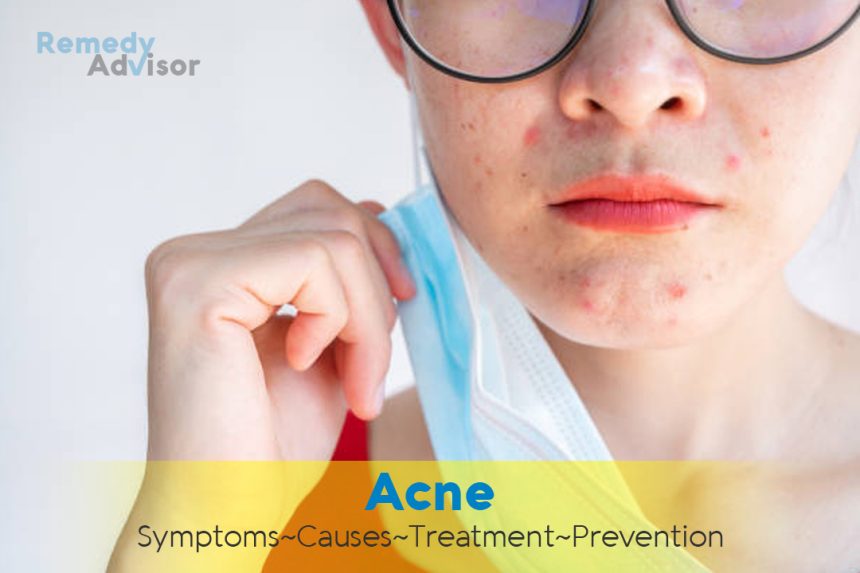What is it?
Acne, a skin condition technically called acne vulgaris^ is the bane of millions of teenagers, but it also strikes adults with its persistent and recur- rent blemishes (red bumps, whiteheads, blackheads, nodules, or cysts) on the skin. It primarily affects adolescents, but one study indicates that even in their 50s, 6 percent of men and 8 percent of women continue to experience outbreaks. Except in severe cases, acne is generally harmless, although it can cause considerable psychological distress.
In both adults and adolescents, acne develops when oil glands in certain parts of the body namely, glands associated with the pores from which face, chest, and back hairs emerge secrete too much sebum, the thick waxy lubricant that acts to retain moisture. Excess sebum clogs the pores. K it remains beneath the skin.
It results in whiteheads; blackheads occur if the plugs of sebum protrude above the skin. Angry red pimples appear if excess secretions invade and inflame surrounding tissue. The more extensive the inflammation, the more likely it will form abscesses and leave permanent scars and pits. Prompt medical treatment of severe acne will help prevent scarring.
Symptoms
- The presence of blackheads, whiteheads, pustules, or cysts, with or without redness and inflammation around the eruptions.
- In adolescents the outbreak occurs mainly on the face, but also on the shoulders, back, neck, and buttocks. In adults it is usually confined to the chin and jawline. For women, symptoms may worsen before the start of each menstrual period.
- Groupings of red, inflamed cysts (cystic acne).
- Pockmarks and scarring (chronic acne).
What causes it?
Acne’s causes at any age aren’t completely understood. As in adolescents, acne flare-ups in adults are linked to various kinds of hormonal changes for women, the hormonal fluctuations that accompany menstruation appear to be a factor. Contrary to conventional wisdom, acne isn’t a sign of poor health or the result of dietary indiscretions, nor is it caused by masturbation or constipation.
There may be a hereditary factor: if one of your parents had acne, there’s a good chance you win have it as well. Other factors linked with acne include certain medications, such as oral contraceptives, corticosteroids, vitamin B12, and lithium. Also, grease, cosmetics, tight clothing, or anything that can block your pores can cause acne. In some instances stress, exposure to dioxin (a contaminant found in herbicides), or climate changes may trigger an outbreak. What if you do nothing?
Acne is not life-threatening, and a mild outbreak will clear up by itself. However, if acne causes emotional distress or if it worsens, a family physician or dermatologist should be consulted.
Home remedies
Acne can’t be cured, but you can take steps to keep mild symptoms under control until they go away.
Use a nonprescription drying lotion or; cream
The most effective over-the-counter; preparations contain benzoyl peroxide, generally sold in either 5 percent or 10 percent solution. This active ingredient has a superficial irritant and drying action that helps loosen the; plugs in the hair follicles. It can take four to six; weeks to experience the full therapeutic effect of the drug.
Wash daily, but not too roughly or too often
Use ordinary soap and water. Don’t waste money on medicated cleansers (the medication just rinses away) or granular facial scrubs (a washcloth does the same job). Facial saunas (actually facial steam baths) may aggravate acne.
Watch what you eat.
There is no scientific proof that nuts or colas can trigger flare-ups, but if they or other foods seem to act as a trigger for you, there’s no harm in avoiding them. Numerous studies have failed to show that even large amounts of chocolate trigger outbreaks of acne. A few people are allergic to chocolate and may develop a rash when they eat it but that’s not acne.
Get your rest.
Flare-ups may also be related to emotional upset and too little rest, at least in some people.
Change your exercise gear.
Working up a sweat exercising while wearing tight-fitting, non- absorbent clothes or sweatbands increases oil production and may contribute to acne.
Take care of your hair
Style your hair away from your face to keep your complexion free of scalp oils, and avoid greasy hair dressings. Pull your hair away from your face when you sleep.
Use water-based makeup
Oil-based cosmetics can block sebum from naturally reaching the skin’s surface. Skip cosmetics entirely if acne is severe. When buying makeup, make sure it’s “noncomedogenic” or “nonacnegenic.” Be sure to remove all cosmetics with soap and water before going to bed. Don’t overdo moisturizing.
Continued exposure to the sun and ultraviolet lamps Should be Avoided
These types of light sources occasionally cause dry-up acne, however they may cause long-term skin damage, which can result in skin cancer, and thus are ill-advised.
Don’t pick at your face
Squeezing and picking increase inflammation and the risks of pitting and scarring. Ask your doctor if you can use a blackhead extractor (this device is available in most drugstores). Before you use the device, first soften the affected area of skin with hot wet compresses for about 10 minutes. Make sure your hands and the extractor are very clean.
Prevention
Acne can’t be prevented, but outbreaks can be lessened by following the measures outlined above.







